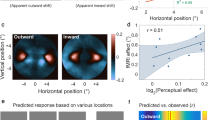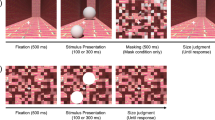Abstract
Two objects that project the same visual angle on the retina can appear to occupy very different proportions of the visual field if they are perceived to be at different distances. What happens to the retinotopic map in primary visual cortex (V1) during the perception of these size illusions? Here we show, using functional magnetic resonance imaging (fMRI), that the retinotopic representation of an object changes in accordance with its perceived angular size. A distant object that appears to occupy a larger portion of the visual field activates a larger area in V1 than an object of equal angular size that is perceived to be closer and smaller. These results demonstrate that the retinal size of an object and the depth information in a scene are combined early in the human visual system.
This is a preview of subscription content, access via your institution
Access options
Subscribe to this journal
Receive 12 print issues and online access
$209.00 per year
only $17.42 per issue
Buy this article
- Purchase on Springer Link
- Instant access to full article PDF
Prices may be subject to local taxes which are calculated during checkout




Similar content being viewed by others


References
Holway, A.H. & Boring, E.G. Determinants of apparent visual size with distance variant. Am. J. Psychol. 54, 21–37 (1941).
Joynson, R.B. The problem of size and distance. Q. J. Exp. Psychol. 1, 119–135 (1949).
Gilinsky, A.S. The effect of attitude upon the perception of size. Am. J. Psychol. 68, 173–192 (1955).
Ono, H. Distal and proximal size under reduced and non-reduced viewing conditions. Am. J. Psychol. 79, 234–241 (1966).
Kaufman, L. & Rock, I. The moon illusion, I. Science 136, 953–961 (1962).
King, W.L. & Gruber, H.E. Moon illusion & Emmert's law. Science 135, 1125–1126 (1962).
Rock, I. & Kaufman, L. The moon illusion, II. Science 136, 1023–1031 (1962).
Kaufman, L. & Kaufman, J.H. Explaining the moon illusion. Proc. Natl. Acad. Sci. USA 97, 500–505 (2000).
Foley, J.M. The size-distance relation and intrinsic geometry of visual space: implications for processing. Vision Res. 12, 323–332 (1972).
Jenkin, N. & Hyman, R. Attitude and distance-estimation as variables in size-matching. Am. J. Psychol. 72, 68–76 (1959).
Leibowitz, H., Brislin, R., Perlmutter, L. & Hennessy, R. Ponzo perspective illusion as a manifestation of space perception. Science 166, 1174–1176 (1969).
McCready, D. On size, distance, and visual angle perception. Percept. Psychophys. 37, 323–334 (1985).
Engel, S.A., Glover, G.H. & Wandell, B.A. Retinotopic organization in human visual cortex and the spatial precision of functional MRI. Cereb. Cortex 7, 181–192 (1997).
Sereno, M.I. et al. Borders of multiple visual areas in humans revealed by functional magnetic resonance imaging. Science 268, 889–893 (1995).
Tootell, R.B. et al. The retinotopy of visual spatial attention. Neuron 21, 1409–1422 (1998).
Somers, D.C., Dale, A.M., Seiffert, A.E. & Tootell, R.B. Functional MRI reveals spatially specific attentional modulation in human primary visual cortex. Proc. Natl. Acad. Sci. USA 96, 1663–1668 (1999).
Ress, D., Backus, B.T. & Heeger, D.J. Activity in primary visual cortex predicts performance in a visual detection task. Nat. Neurosci. 3, 940–945 (2000).
Barlow, H. Temporal and spatial summation in human vision at different background intensities. J. Physiol. (Lond.) 141, 337–350 (1958).
Kersten, D. Spatial summation in visual noise. Vision Res. 24, 1977–1990 (1984).
Richards, W. Apparent modifiability of receptive fields during accommodation and convergence and a model for size constancy. Neuropsychologia 5, 63–72 (1967).
Whitney, D. et al. Flexible retinotopy: motion-dependent position coding in the visual cortex. Science 302, 878–881 (2003).
Richards, W. Spatial remapping in the primate visual system. Kybernetik 4, 146–156 (1968).
Marg, E. & Adams, J.E. Evidence for a neurological zoom system in vision from angular changes in some receptive fields of single neurons with changes in fixation distance in the human visual cortex. Experientia 26, 270–271 (1970).
Trotter, Y., Celebrini, S., Stricanne, B., Thorpe, S. & Imbert, M. Modulation of neural stereoscopic processing in primate area V1 by the viewing distance. Science 257, 1279–1281 (1992).
Dobbins, A.C., Jeo, R.M., Fiser, J. & Allman, J.M. Distance modulation of neural activity in the visual cortex. Science 281, 552–555 (1998).
Anderson, C.H. & Van Essen, D.C. Shifter circuits: a computational strategy for dynamic aspects of visual processing. Proc. Natl. Acad. Sci. USA 84, 6297–6301 (1987).
Larson, G.W. & Shakespeare, R. Rendering with Radiance: the Art and Science of Lighting and Visualization (Morgan Kaufmann, San Francisco, 1996).
Acknowledgements
We thank S. He, F. Fang and P. Sinha for their comments and suggestions related to this manuscript. This work was supported by the US National Institutes of Health (F32 EY015342 to S.O.M. and RO1 EY-015261 to D.K.) and the National Geo-Spatial Intelligence Agency (HM1582-05-C-0003 to S.O.M.).
Author information
Authors and Affiliations
Corresponding author
Ethics declarations
Competing interests
The authors declare no competing financial interests.
Supplementary information
Supplementary Methods
Additional behavioural measurements (PDF 60 kb)
Supplementary Data
Across subject comparison of behavioural and fMRI effect size (PDF 50 kb)
Supplementary Note
Binocular viewing and vergence eye movements (PDF 43 kb)
Rights and permissions
About this article
Cite this article
Murray, S., Boyaci, H. & Kersten, D. The representation of perceived angular size in human primary visual cortex. Nat Neurosci 9, 429–434 (2006). https://doi.org/10.1038/nn1641
Received:
Accepted:
Published:
Issue Date:
DOI: https://doi.org/10.1038/nn1641
This article is cited by
-
Behavioral examination of the role of the primary visual cortex in the perceived size representation
Scientific Reports (2023)
-
Better models of human high-level visual cortex emerge from natural language supervision with a large and diverse dataset
Nature Machine Intelligence (2023)
-
Does perceiving require perceptual experience?
Review of Philosophy and Psychology (2023)
-
The human primary visual cortex (V1) encodes the perceived position of static but not moving objects
Communications Biology (2022)
-
What do we see in pictures? The sensory individuals of picture perception
Philosophical Studies (2022)

